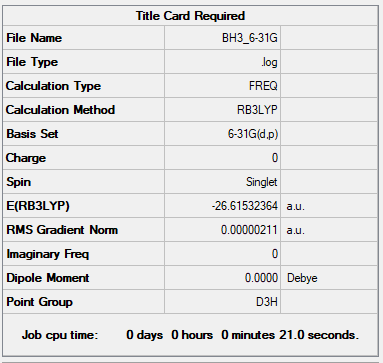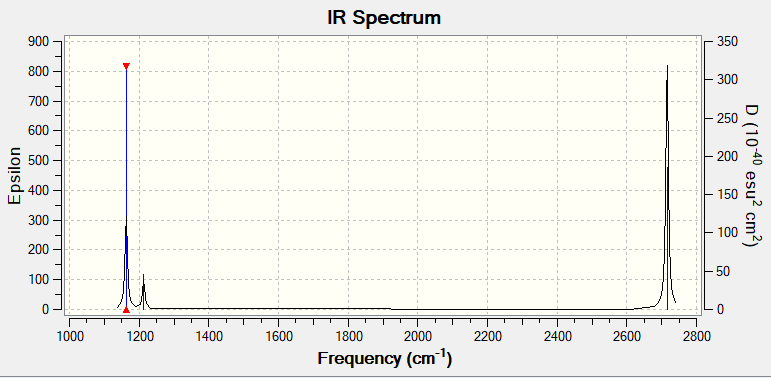Rep:Mod:jc6116 1
BH3 Molecule
Basis Set
B3LYP/6-31G(d.p.)
Summary Table
Item Table
Item Value Threshold Converged? Maximum Force 0.000004 0.000450 YES RMS Force 0.000003 0.000300 YES Maximum Displacement 0.000017 0.001800 YES RMS Displacement 0.000011 0.001200 YES
BH3 molecule |
Frequency Analysis
Low frequencies --- -11.6892 -11.6814 -6.5475 0.0011 0.0281 0.4290 Low frequencies --- 1162.9746 1213.1390 1213.1392
Frequency Link
Media:Jc6116_BH3_FRE_6-31G.LOG
Vibrational spectrum of BH3
| wavenumber (cm-1) | Intensity (arbitrary units) | symmetry | IR active? | type |
| 1163 | 93 | A2" | yes | out-of-plane bend |
| 1213 | 14 | E' | very slight | bend |
| 1213 | 14 | E' | very slight | bend |
| 2582 | 0 | A1' | no | symmetric stretch |
| 2716 | 126 | E' | yes | asymmetric stretch |
| 2716 | 126 | E' | yes | asymmetric stretch |
There are totally 6 vibration modes, but from the IR spectrum only 3 peaks can be observed, which are 1163.6 cm-1, 1213.6 cm-1, 2713.1 cm-1.
Due to the fact that Mode 2 and Mode 3 are degenerate, Mode 5 and Mode 6 are degenerate.
In addition, Mode 4 (2580 cm-1) is not shown in the spectrum since all the dipole moments cancelled out with each other hence it's IR inactive.
LACO MO of BH3
Q1. Are there any significant differences between the real and LCAO MOs?
LCAO MOs does not provide an actual description of the molecular orbitals but an optimised and predicted one, forming by each of the AOs, which can be used as reference of the real MOs. As it can be seen from the previous MOs diagram, real MOs have the exact sizes of orbitals, and the shape of orbitals and their overlap are shown clearly.
Q2. What does this say about the accuracy and usefulness of qualitative MO theory?
The accuracy of the qualitative MO is not as high as the real MOs but it is a reliable prediction of the real MO hence is quite useful.


